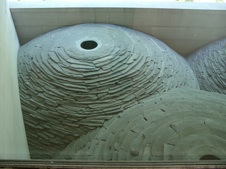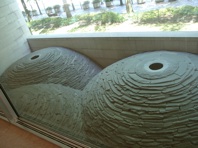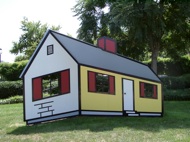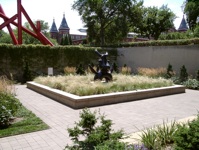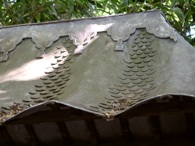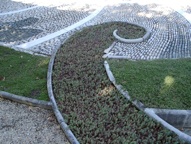arslocii
placeness as art


arslocii
placeness as art









Quest for artistic endeavor
in the nation’s capital city
We went out looking for art-and-site symbiosis in our center of government and showplace of our cultural heritage. It is funny how much art in the National Gallery is not national at all – or, more precisely, not our nation. In typical military/industrial politics-speak, “national” must be shorthand for “international.”
We splurged and rode the Acela train to D.C. It’s cleaner and faster and pricier than the regular Amtrak and resembles the interior of a plane more so than the usual dark and dreary older train cars with named routes. Besides, everyone seated in our “quiet car” was wearing a suit – except for us – and that, too, is a noticeable difference. And they all had laptops. Probably all lobbyists. And the new improved Union Station now feels like any major metropolitan airport, which fits well with the Acela’s style. Whatever, we got there quickly and hit the arslocii running.
The National Gallery
Our purpose here was twofold: to see the installation by Andy Goldsworthy in the East Wing and to check out the Sculpture Garden. In addition, we went through most of the rest of the East Wing and much of the West as well.
“Roof” (2004-05) is an unusual piece for Goldsworthy since it is in an unnatural, manmade space, part inside and part outside the building. It consists of nine domes or cairns, each about 6’ high and maybe 25’ in diameter, which entirely fill a walled courtyard, intersecting and overlapping each other and any barriers they meet, including stone walls, steps and glass curtain walls. Built of stacked slate, and emerging from an entirely hard-surfaced exterior environment, these domes manage, somehow, to soften and “organicize” a severely rectilinear space, and jut out beyond a wall of glass with their rounded forms and crowded grouping. The domes interact with each other, intersecting, bumping and merging like land masses, islands – evoking a seascape or mountains, massive but buoyant. A few of the rounded masses penetrate the glass wall that separates them from the viewer: a little ooze-through here, a big intrusion there. They conjure hives, settlements, ancient volumes, primitive forms, gentle giants – a school of whales. A suggestion of unearthing a previous civilization but, more contemporaneously, undermining the presumption of the monumental in D.C., i.e., the Capital dome. Are they being kept out or, rather, held in? Are they emerging or have they been excavated, built into the building or the building built around their unmovability? There is at once a sense of both compression and expansion, containment vs. the pooling of free-floating shapes. From the mezzanine level you can view down onto the black, perfect circles at their summits: voids, vortexes, occuli, birds’ nests, kivas. Using an otherwise horrible dead space similar to an aquarium tank, this gigantic cluster of geometric mounds gets blood from a stone(pile).
The Sculpture Garden – after having just seen the well-integrated “Roof” sculpture – does not live up to the same standards. Basically, the “garden” is a public square with a large fountain at its center and radiating walkways, leaving small wedges of grass and some trees between and around the perimeter: these are the sculpture sites. Although populated by heavy-hitter artists, the garden’s siting, unfortunately, does nothing for them, and they become just plopped-down decorations that one passes on the way to the water feature and food carts. Certainly, they enliven the park but the park does nothing for the art, sometimes even, as situated, rendering 3-D pieces as 2-dimensional by not allowing a 360 degree view. Ironically, one piece that works best is Lichtenstein’s “House I” because it is 2-D and is painted to look 3-D. In this “garden,” all the artwork is on the outer perimeter while everybody sits facing in toward the central fountain – this is really not about the art but rather maybe more about the names of artists.
Hirshhorn Sculpture Garden
The Hirshhorn, directly across the wide, empty, desolate Mall from the National Gallery’s sculpture garden, is the more thoughtful installation. We were here about thirty years ago, not very long after it opened to the public. The Hirshhorn Sculpture Garden was of interest then because the viewing spaces or rooms were structured around the works, and that seemed unique at the time. New works have since been added, and now there is some garden, where before it was mostly hard surfaces and white walls. But what we now know is that, perhaps right after seeing it in 1978-79, the garden was closed for a few years and redesigned, thankfully, by a landscape architect, Lester Collins. The surprising thing is that it is such a small space for sculpture and yet, as it is multi-leveled, it contains far more sculpture than you might think possible. It is a clever use of space and a decent mix of green and hard. A kind of maze to follow in terraced fashion and to set off art – here, at least, art is the point.
A few of the better works not sited in the garden unfortunately get treated as “turds on the plaza” in the huge emptiness of the fascist-style hovering architecture and its landing pad: the museum building. For example, Oldenburg’s “Mouse” looks expired as a result of its spirit-killing setting, and Lichtenstein pulls off another coup of painting as sculpture. In the garden, however, the works are treated better in their more purposeful siting, allowing them space and different vantage points in a fairly tight area. Generally speaking, the National Gallery has some better pieces to display but no good way to site them. They are, of course, a national collection rather than a personal one, as is the Hirshhorn. Here’s a suggestion: Why not take the perfectly hideous and dead Mall and make it into a sculpture park for our national psyche to be proud of? Hire the landscape architect from Storm King to do a plan, incorporate the collections from both museums and expand them across the Mall, extending their scope and power. We’re talking only gain here.
Dumbarton Oaks
Its reputation preceded it and it lived up to it. What a garden this is! Beatrix Farrand is another genius landscape architect with Harvard as well as Brookline, Massachusetts, connections (just like Thomas W. Sears). Though now only 16 acres, small in area compared to country estates (it was itself originally an estate of 43 acres from the early 1800s, bought in the 20th century by Mildred and Robert Woods Bliss), it is huge by the measure of the surrounding city gardens of Georgetown. Keep in mind that these gardens reflect the kind of modern approach of the 1920s-1960s and, at the same time, refer to antiquity. It’s kind of uncanny how the gardens unfold at Dumbarton Oaks, a series of rooms that keep getting more exciting as one moves further from the house. It’s all there: terraces, circuitous routes and surprises unfurling like a runaway roll of fine silk, beginning at your entry point through an imaginative Orangery from 1810. Farrand, brought in to redesign and structure the landscape, was not afraid of hardscape, nor was she shy about texture. This is the most textural garden on a grand scale we’ve ever seen. It often takes one’s breath away. And yet, somehow, it manages to avoid being gaudy or tasteless. From the first overlook of the Pebble Garden (which is pretty awesome) and your actual experience in it when you climb to the lower terraces – it just keeps getting better. Some of the more hidden rooms have a wow factor, too; they are not as showy as some spots but are powerful nonetheless. The magnificent Growing Garden transports you to, perhaps, Bruges in the 17th century, and a classical-style amphitheater surrounding the Lovers’ Lane Pool actually has tiered seating for 50 and urn-topped column “walls” strung together with iron-chain swags. Even drainage ditches are works of art at Dumbarton, and the plant collection is in perfect synchronicity with the themed gardens. The Swimming Pool, the nearby Loggia with its mosaic murals, the almost Baroque adjacent Horseshoe Fountain: this small cluster alone would be enough of a splendid garden in its own right. But there is so much more. Dumbarton, in its particular partnership of nature and nurture, and its affinity for classical design, updates the traditions of and references to all landscape history and creates an exceptional garden for its own century, and those to come. The use of the topography and layout is to be honored, too, with Farrand guided by the motto of her mentor, Harvard Professor Charles Sprague Sargent, to “make the plan fit the ground and not twist the ground to fit a plan.” She has made it so, and gone beyond, to create arslocii.
(Just a geographically-out-of-place-but-necessary-to-mention P.S. here about another Farrand-designed gem on a much smaller scale – the garden at Bellefield, a colonial-era estate, which now is part of the Roosevelt-Vanderbilt National Historic complex in Hyde Park, NY. Created in 1912 to be a simple country garden, there is nothing simple about it. Completely surrounded by a high stone wall with a few arched doors to pierce its protectiveness, it is a bit like a cloister garden, except that it is lush and seductive like no medieval garden would be; one of its open doors, like an apple-bearing serpent, beckons the viewer in. The structural formality is readable and understandable, and coexists on an equal footing with the richness and layering of plantings (not her originals), pairings and juxtapositions that stimulate and calm simultaneously – still managing to balance the hardscape of the container and the softness of the contained. Bellefield’s garden could be one of the garden rooms at Dumbarton Oaks, but it is complete in and of itself. A fairy-tale assemblage of texture and color, it is Mr. McGregor’s garden for hungry eyes rather than mouths.)

arslocii, a creation of Probasco Haus Press
copyright © 2010 Probasco Haus Press LLC

Top Left: Goldsworthy’s “Roof,” detail from above.
Bottom Left: Dumbarton Oaks’ Growing Garden, view toward garden sheds.
Right: Hirshhorn Sculpture Garden’s “Post-Balzac,” by Judith Shea.


